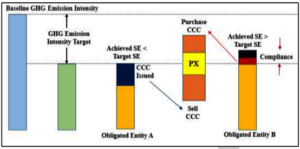Understanding Indian CCTS
- March 3, 2024
- Posted by: BiconAdmin
- Category: Carbon Credit Trading Scheme (CCTS)
Understanding Indian CCTS
Indian Carbon Market (ICM) is established under the purview of the Energy Conservation Act, 2001, and the Environment (Protection) Act, 1986. The Energy Conservation Act, 2001 empowers the Government of India to specify the Carbon Credit Trading Scheme (CCTS), where any entity, including the designated consumers, registered for carbon credit trading scheme will be the “registered entity”. The act empowers the Central Government to issue the “Carbon Credit Certificates” to the registered entities under different mechanisms. While the Environment (Protection) Act, 1986 empowers the Government of India to specify standards for emission or discharge of pollutant for the obligated sectors.
Compliance Mechanism of Indian Carbon Credit Trading Scheme
- The Carbon Credit Trading Scheme envisages the Compliance Mechanism, whereby the registered entities which are notified under the compliance mechanism are called as ‘Obligated Entity’.
- The Ministry of Environment, Forest and Climate Change (MoEFCC) shall notify the GHG Emission intensity targets in terms of tons of carbon dioxide equivalent (tCO2e) per unit of equivalent product for each cycle of defined trajectory for the considered obligated entities.
- The obligated will be notified an annual target for a three-year trajectory period and on completion of trajectory period, the targets shall be revised.
- The Obligated Entity notified in any trajectory period shall comply for each annual year (compliance cycle) with the GHG emission intensity targets assigned to it.
- The obligated entity who exceeds the targeted GHG emission intensity in any compliance cycle are entitled for issuance of the Carbon Credit Certificates based on the difference in the achieved GHG emission intensity and targeted GHG emission intensity for the production quantity in the relevant compliance cycle.
- The obligated entity who fails to achieve the targeted GHG emission intensity in any compliance cycle are entitled to purchase the Carbon Credit Certificates based on the difference in the achieved GHG emission intensity and targeted GHG emission intensity for the production in the relevant compliance cycle.
- The obligated entities can purchase the CCC to meet the GHG emission intensity targets in each compliance cycle.
- The illustration given below shows that the Obligated Entity ‘A’ are issued CCC on achieving the GHG emission intensity greater than the target GHG emission intensity while the Obligated Entity ‘B’ is entitled to purchase the CCC to meet their GHG emission intensity targets from Indian Carbon Market.
 The Obligated Entity ‘A’ can sell their CCC, and the Obligated Entity ‘B’ can purchase the CCC over the trading exchange.
The Obligated Entity ‘A’ can sell their CCC, and the Obligated Entity ‘B’ can purchase the CCC over the trading exchange.
GHG Emission Intensity Trajectory and Targets
Obligated Entities
- The Central Government in consultation with the Bureau, having regard to the intensity or quantity of energy consumed and the amount of investment required for switching over to energy efficient equipment and capacity of industry to invest in it and availability of technology and equipment required, specifies some user or class or users of energy as Designated Consumers in S.O. 394(E) dated 12th March 2007 and subsequent amendments.
- The Central Government shall decide the Designated Consumers that can be notified under the compliance mechanism of the Carbon Credit Trading Scheme.
GHG
Greenhouse gas (GHG) emissions shall be converted to CO2 equivalent (CO2e) basis the Global Warming Potential (GWP) for the Greenhouse Gases (GHGs) as specified in India’s Biennial Update Report (BUR 3) under UNFCCC. This conversion allows for standardized and consistent measurement of different GHGs based on their warming potential relative to carbon dioxide.
GHG Emission Intensity Trajectory and Targets
1. The GHG emission intensity reduction trajectory will be developed for the considered sectors based on the:
(i) India’s nationally determined contribution commitments.
(ii) Potential for fuel switch, use of non-fossil fuel energy/feedstock and decarbonisation in the sector.
(iii) available technology and associated cost of their implementation.
2. The GHG emission intensity reduction target shall be specific for every obligated entity for any sector and shall be determined based on:
(i) The GHG emission intensity reduction trajectory developed for that sector.
(ii) Average rate of reduction in GHG emission intensity across all the obligated entities for that sector determined based on the historical data.
3. The trajectory period will be of three years and the targets will be given on annual basis that has to be complied by the Obligated Entity which is defined as compliance cycle.